Whether a recreational blogger or a big-name influencer, creators are finding ways to cash in with their content.
Whatever your passions, skills, and ambitions, there are exciting opportunities to craft compelling and valuable content that engages a paying audience.
Nowadays, there are more content platforms, tools, and routes to monetization than ever before. It’s a space with low barriers to entry and minimal start-up costs, offering endless potential to grow and scale.
Even better, you can get started today crafting and posting content that might lead to you becoming a full-time creator.
Here, we take a close look at how content creators make money, including monetization options across the main social media platforms. We also give you an idea of how much you can make.
The Content Creator Economy in 2024
Before we get into how you make money, we need to answer the question, can you make money as a content creator in 2024?
The good news is that the answer is: YES.
By now, it might seem like the content space is saturated, but demand continues to grow across areas like e-learning (courses) and ebooks.
Our very own stats show that by 2027, there will be 1.1+ billion ebook consumers, while consultant Devlin Peck found e-learners will top 57 million.
Social media engagement also remains strong.
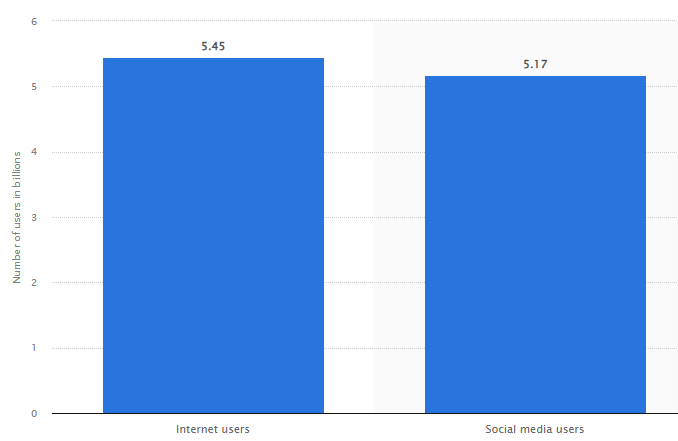
According to Statista, there were 5.17 billion social media users globally (as of July 2024). To put this in context, this is equal to 63.7% of the world’s population. It also represents a rise of 4.44% from 2023.
Brands increasingly use the platforms to connect with consumers, while users seek out ideas and recommendations.
A global survey of 14,000 consumers by Bazaarvoice’s Influenster community found an eye-opening 73% actively shop via social media. Meanwhile, 65% turn to social platforms to seek out ideas for what to buy.
This all signals opportunity—for creators to monetize their own content and cash in by helping connect brands with consumers.
A final thing to take away from this is that while there are lots of content creators out there, a huge number of them are not maximizing their potential.

Out of all the new creators out there, 59% are not monetizing their content and 35% aren’t earning a “livable income”.
It might sound disheartening but it really means that you can get out ahead of the competition.
If you approach content as a business and develop a solid monetization strategy, you can take advantage of the thriving creator economy.
- The State of The Creator Economy in 2024
- How Much Money Do Content Creators Make? (Plus How You Can Make Money Too)
How Content Creators Make Money
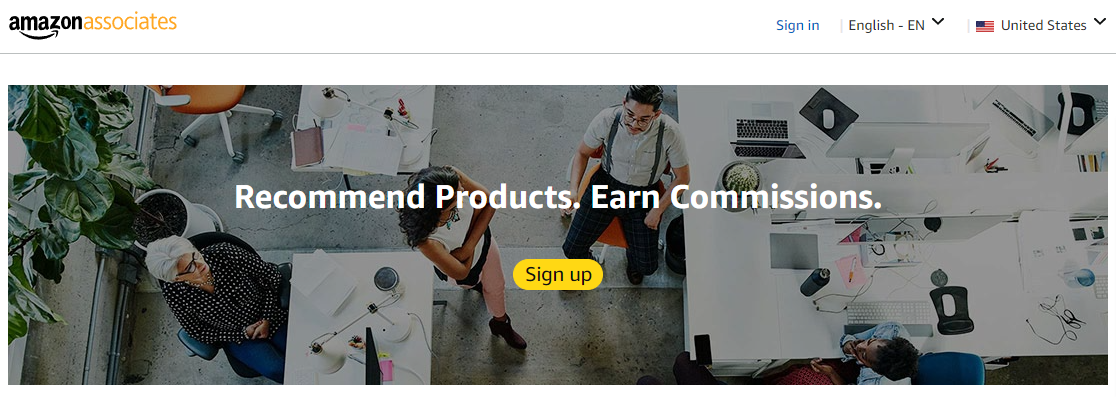
There are lots of ways to monetize content, from subscriptions and advertising to affiliate marketing and brand sponsorships.
The types of money-making opportunities often depend on the kind of content you produce. The main monetizable content types include:
- Text (blogs, websites, ebooks, etc.)
- Images
- Videos
- Podcasts
- Webinars/live streaming
- Courses
- Music
- Newsletters
- Downloads
- Apps
- Social media content
Essentially, any type of content that you create has monetization potential. The main things to avoid are:
❌ Trying to profit from other people’s copyrighted work without permission
❌ Spamming people with zero-value content just to get them to click a link
❌ Publishing offensive content that is likely to get you kicked off social media and other monetization platforms
❌ Not taking steps to protect users’ private and personal data
In general, content monetization can be grouped into the following activities:
Selling access to content
This involves anything to do with users paying you for access to what you create, such as:
✅ Creating a course and getting students to sign up to access the lessons
✅ Writing and self-publishing ebooks
✅ Launching a membership site or subscription offer
✅ Publishing a “freemium” website with a mix of free and paid content
Selling access to an audience
This involves anything to do with getting paid to help brands connect with your audience for the purpose of boosting sales, so things like:
✅ Affiliate marketing, which earns you a commission
✅ Brand sponsorships and influencer marketing
✅ Revenue sharing arrangements
✅ Running ads within your content
How do content creators become influencers?
The main difference between content creators and influencers is in the name. Anyone can create content and post it. However, influencers become an authority in their niche to the extent that what they post can persuade their followers to buy certain products and services.
Moving from content creator to influencer means building a following, engaging with fans, and establishing brand relationships. Influencers get paid to promote and recommend products/services.
For example, lifestyle content creator Khaby Lame gets up to $750k per sponsored post through his tie-up with Hugo Boss.

The space ranges from nano-influencers, who have fewer than 1k followers, to mega-influencers with 1m+.
The Best Ways to Sell and Monetize Content
Successful creators leverage a variety of platforms to monetize their content. Here are the main places where you can profit from what you create:
Content monetization platforms

Whatever type of content you create, there are platforms out there that support its monetization. The platforms usually charge a flat fee or take a percentage of each sale. They process payments and handle other admin tasks, so you can sell your content (or access) directly to customers.
Some platforms specialize in monetizing certain types of content, such as podcasts or courses.
Meanwhile, all-in-one platforms—like Whop—give you the tools to monetize all kinds of digital content and create your home on the internet, giving you the flexibility to scale your creation business.
Blogs and websites
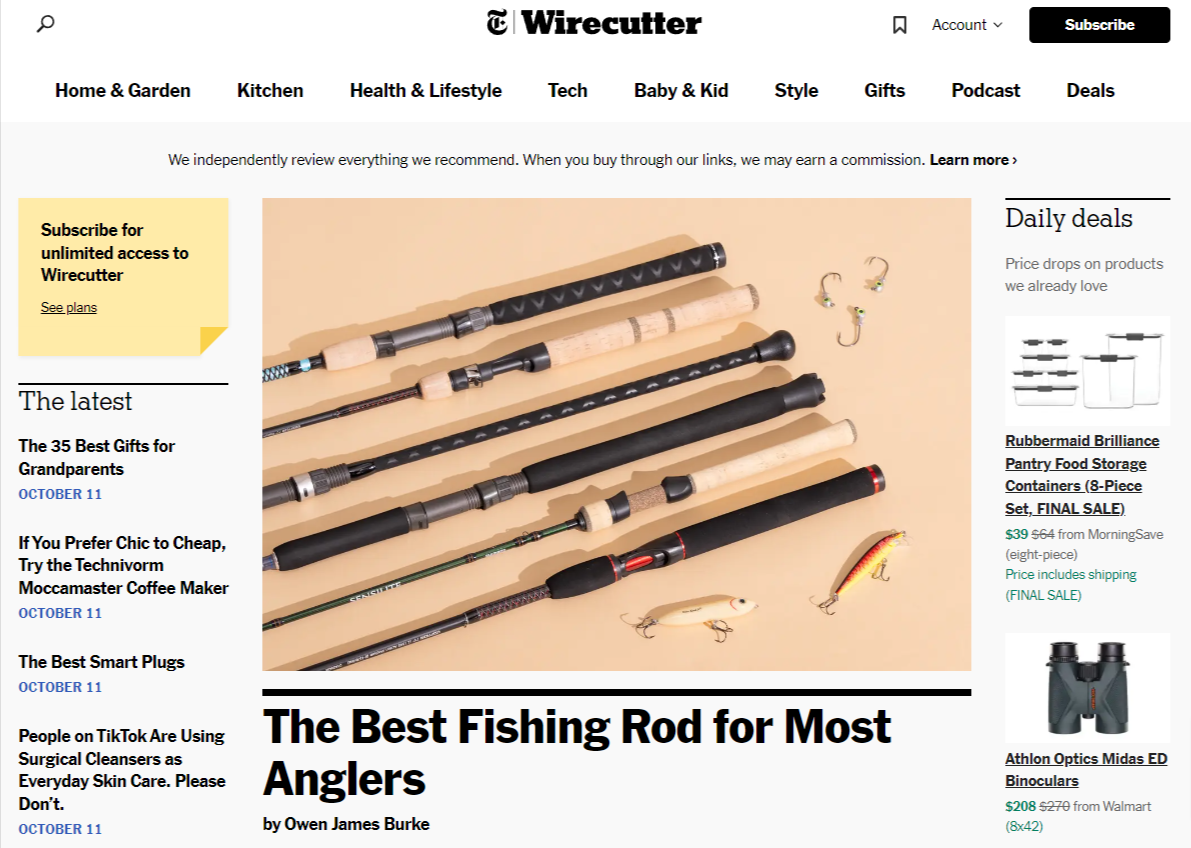
A blog or website supports all kinds of content monetization, such as affiliate marketing and selling ebooks and other digital products. You can find sites devoted to product reviews and recommendations, sites that feature sponsored content, and sites that sell advertising space.
Tipping/rewards

Once you’ve built your audience, you can cash in with your content indirectly by offering fans the option to give you a tip or even a gift. Platforms like Buy Me a Coffee and Throne exist to connect creators and their audiences, whereas all-in-one platforms like Whop allow you to accept donations with a tipping link.
Social media
One of the most popular places to monetize content is social media. These platforms offer the chance to connect with a large, global audience. Sell products and services directly or take advantage of the various features the platforms offer to support creators in monetizing their content.
Let’s take a deeper dive into how content creators make money on three of the top social media platforms—TikTok, Instagram, and YouTube.
How do Content Creators Make Money on TikTok?

TikTok is focused on short-form videos of up to 60 seconds. It has around 1.04 billion monthly active users and is especially popular among younger viewers, with 38.5% aged 18-24. Among the monetization tools TikTok provides is the TikTok Creator Marketplace, which connects brands and agencies with qualified creators.
The main ways to monetize TikTok content are:
TikTok Creator Rewards Program
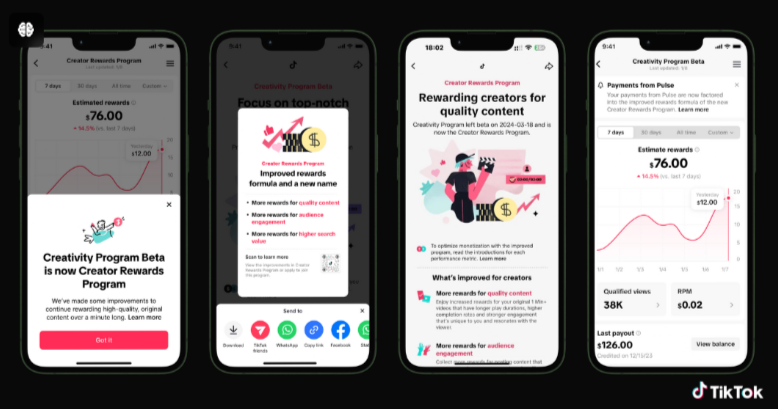
Previously called the Creativity Program, the TikTok Creator Rewards Program helps creators make money from their original content on the platform. Eligibility requirements include having 10k+ followers and 100k+ video views. Only personal accounts are accepted.
At the time of writing, the program is in beta. It’s currently available in selected countries, including the U.S., and payouts in the program depend on various TikTok metrics. Earnings are in the region of $4 to $8 per 1k video views, higher than under the Creativity Program.
TikTok Pulse

This is TikTok’s revenue-sharing offering. It gives creators 50% of the revenue from sponsored posts placed next to a creator’s TikTok content. Eligibility requirements include having 100k+ followers and being part of the TikTok Creator Marketplace.
Brand partnerships/influencer marketing
TikTok supports efforts to engage in promotional activities through partnering with brands, affiliate marketing, and influencer marketing. One of the platform’s requirements is that creators are transparent with users about content that is aimed at promoting products or services.
Gifts
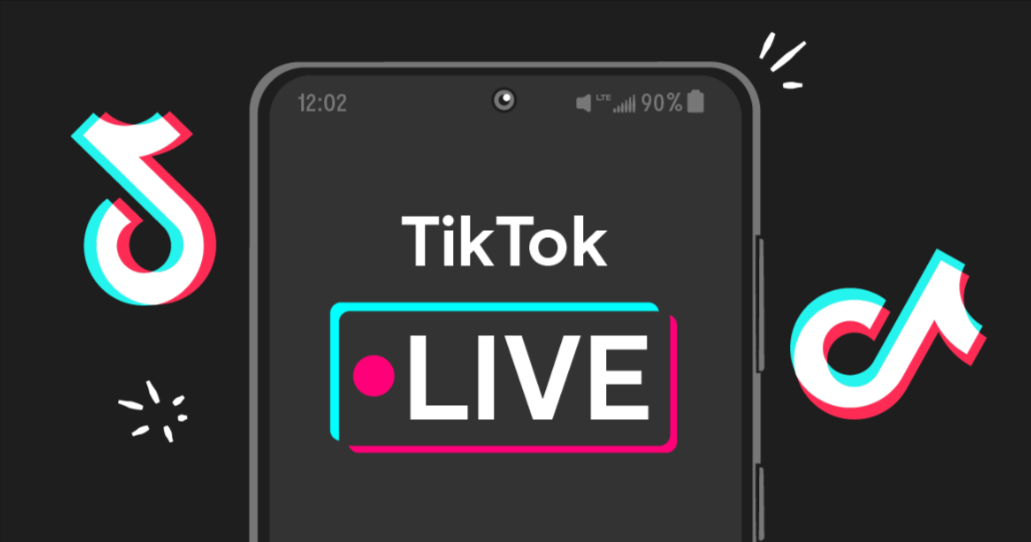
This feature lets fans send creators virtual Gifts in appreciation of their TikTok LIVE videos. Users buy Coins, which they can give to creators in the form of Diamonds. Creators exchange the virtual gifts for actual cash, once they reach $100 (TikTok takes 50%). Gifts can also be given to reward certain types of non-live-streamed TikTok videos.
If you’re a U.S.-based content creator, you’re probably aware of the current issues around TikTok. So, while there are monetization opportunities to exploit, it’s a good idea to diversify your efforts to protect your income over the long term.
- TikTok Statistics for 2024
- A Complete Guide to the TikTok Affiliate Program: How You Can Earn Commission on TikTok
How do Content Creators Make Money on Instagram?

If you want to monetize content, Instagram should be on your radar. Each month, around 2.35 billion users are active on the platform, putting it fourth behind YouTube, WhatsApp, and Facebook.
Instagram remains an image-driven platform, which makes it a great way to showcase visual content. As well as regular posts that live in your main feed, you can leverage Instagram Stories and Reels to highlight specific products or content.
The main ways to monetize Instagram content are:
Creator Marketplace
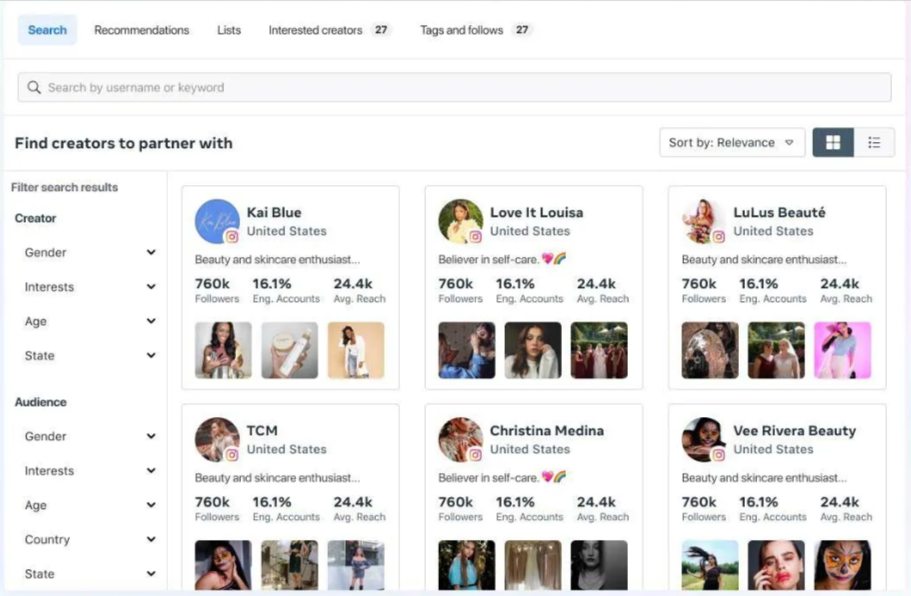
Similar to the TikTok marketplace, the Instagram Creator Marketplace is a way for creators and brands to connect. It’s also in beta, with the marketplace currently open only to U.S.-based creators. Instagrammers can add their interests and niches to make themselves available for promotional campaigns and branded content opportunities.
Live Badges
Users can purchase badges that appear as hearts on creators’ live videos. The badges cost $0.99, $1.99, and $4.99, so making money here means getting a lot of views. Once the creator has reached $100, they can receive a monetary payout. Eligibility requires 10k+ followers, with the feature available to non-U.S. creators on an invite-only basis.
Creator Fund
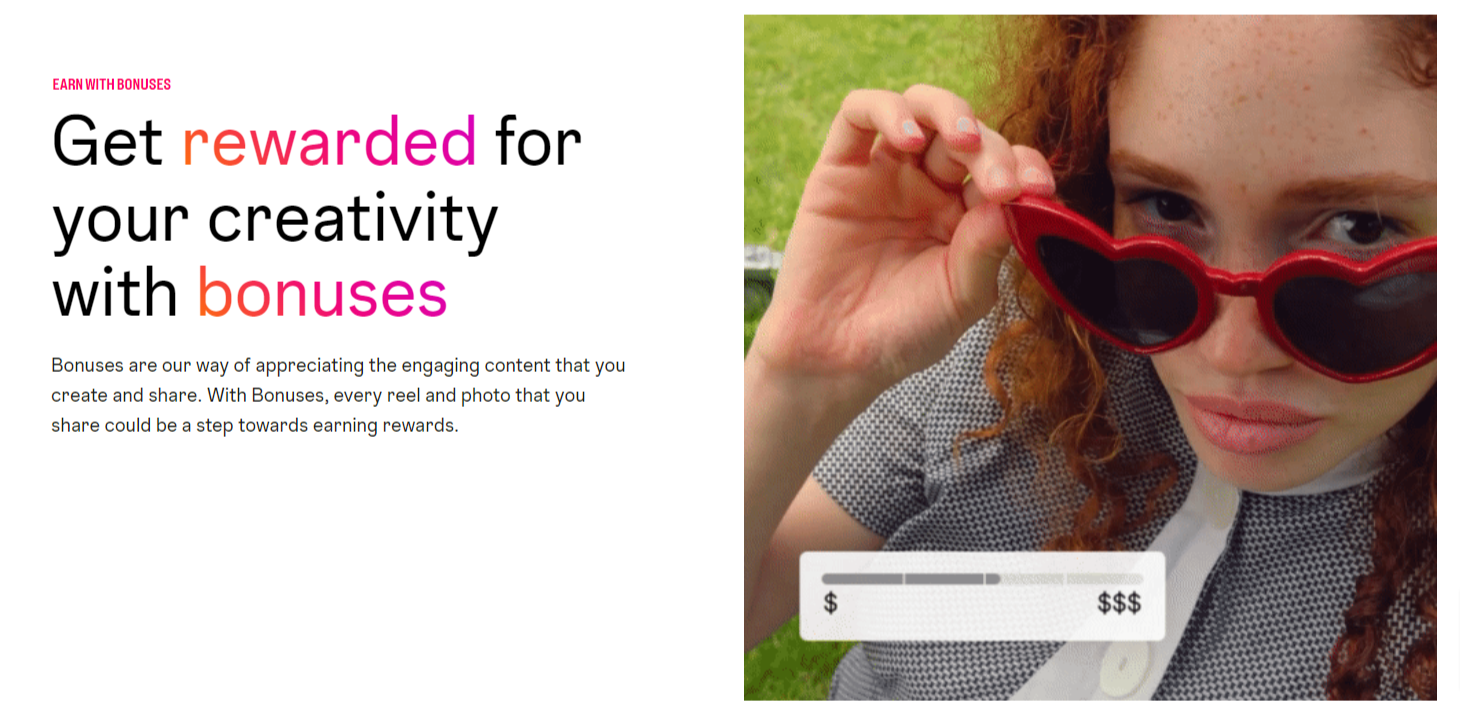
This offers the opportunity to earn money via Live Badges and the invite-only Bonuses program. Eligibility includes opening an Instagram Creator account. It also requires posting great content that regularly gets strong user engagement. Payouts depend on metrics such as the number of post views.
Paid subscriptions
Instagram allows creators to benefit from monthly recurring revenue by setting up paid subscriptions. Users who become subscribers get access to exclusive content. Eligibility requirements include having 10k+ followers.
- How to Get Monetized on Instagram: 15 Proven Ways to Make Money
- How to Sell on Instagram: Best Practices, Trends, and Examples
How do Content Creators Make mMoney on YouTube?

As you’ll see in the next section, many of the highest-earning content creators are mostly known for posting videos on YouTube. Videos are a popular and flexible format that supports all kinds of monetization opportunities.
Content supported by YouTube includes long-form videos, which are great for things like product reviews, entertainment, and vlogs. There are also YouTube Shorts, which support easily digestible content. Shorts were previously between 15 and 60 seconds but have recently been extended to up to three minutes.
The main ways to monetize YouTube content are:
YouTube Partner Program (YPP)
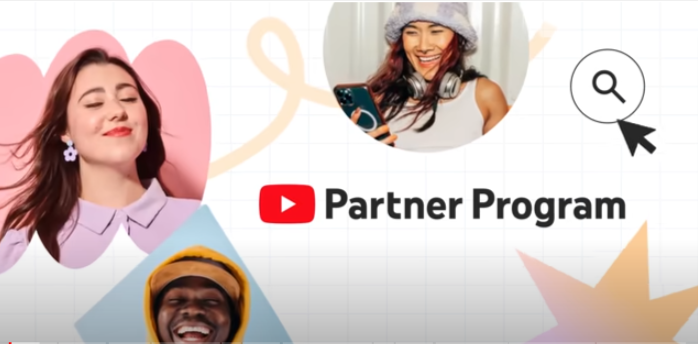
The YouTube Partner Program (YPP) allows content creators to run ads on their videos. Revenue income is split 45/55, with the content creator getting the lion’s share. To qualify for YPP, you need at least 1k subscribers with content views of 4k or more across 12 months.
Channel memberships
This is one of the “fan funding” options offered by YouTube. You can set a membership option for users to sign up and pay for extra stuff, such as bonus content. Eligibility requirements include being a part of the YPP. There are some content restrictions here, with memberships not allowed on channels classified as “Made for Kids”.
Other fan funding opportunities
As well as memberships, YouTube offers fan funding through Super Chat, Super Stickers, and Super Thanks. They each work slightly differently but basically involve your fans paying to be featured in your live chat streams or comments section. For all of these options, the channel you want to monetize must be in the YPP.
YouTube Premium
YouTube Premium is a platform-wide feature, which lets viewers avoid ads in return for a monthly subscription. Selected YPP creators can take a share of YouTube Premium income (to make up for missing out on ad revenue).
YouTube Shopping
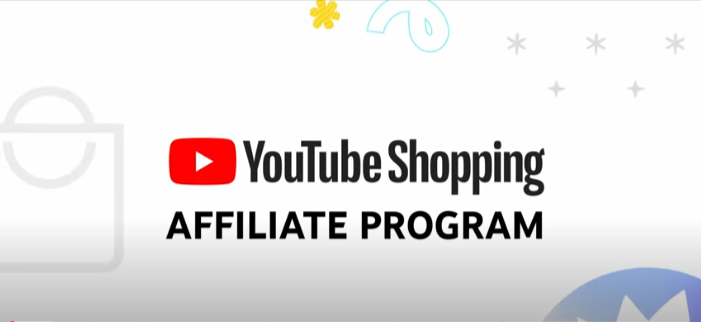
YouTube has its own affiliate program. The Shopping feature lets you tag products within videos, earning commission on each converting lead. Requirements to take part include your channel being a YPP member and having 10k+ subscribers.
Brand sponsorships
Content creators on YouTube can enter into partnerships with brands. Creators use their videos to promote the brand’s products. Examples include product reviews or paid sponsorships. Another type is affiliate marketing…
Affiliate marketing
Along with YouTube Shopping, you can run affiliate marketing on YouTube by making product recommendations within videos, with affiliate links placed in the description and on the end cards. YouTube doesn’t prohibit affiliate marketing but excessive posting might flag as spam.
- YouTube Channel Ideas That Can Make You Money Online
- The Minimum Subscribers Needed to Make Money on YouTube (and How You Can Grow Your Channel)
The Average Earnings of a Content Creator
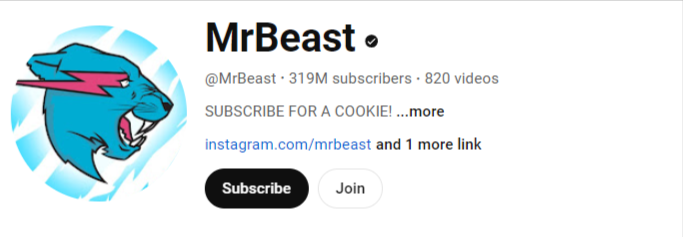
Before we look at what a typical content creator makes, let’s see what the top earners raked in last year, according to Statista:
MrBeast (Jimmy Donaldson): Hosts challenges and giveaways, which have gained 319 million YouTube subscribers. $82m
Rhett & Link: Comedy duo known for sketches, songs, and hosting a YouTube series, which has gained a total following of 51 million. $35m
Preston Arsement: Gamer, whose three YouTube channels have a combined 52 million subscribers. $35m
Ryan Kaji: Behind children's YouTube channel Ryan's World, which boasts 57 billion views and $1bn in sales (oh, and he’s 13 years old…). $35m
Jake Paul: Best known as a boxer, with an Instagram following of nearly 27 million and 21 million on YouTube. $34m

As well as the eye-watering eight-figure earnings, this list shows the diversity of the content creation space. It also highlights that video-based content is where the big bucks can be found.
So, moving on to what you could make as a content creator, the numbers are a bit more modest but still impressive.
Given all the variables at play, it’s difficult to put an exact dollar amount on content creator income. However, here is an idea of how much people like you are making across the main platforms:
💰 U.S.-based content creators across all platforms make an estimated $49k to $79k per year
💰 Content creators on TikTok make on average between $15k and $25k a year
💰 Full-time YouTubers rake in approx. $60k a year
💰 Instagrammers with 1k to 10k followers can reach up to $35k per year
The great thing about being a content creator is that the sky’s the limit. You can focus on one thing and blow it up or continually pivot and keep your audience guessing.
The most important thing is to build your brand and create content that people find valuable.
5 Tips for Making Money as a Content Creator
Ready to start or grow your content creation business? The great thing is that nothing is stopping you from launching right now.
How much money you can make in the content space depends on factors like:
- How often you post
- Content type and platform
- Size of your audience
- Routes to monetization
So, if you want to really scale, think about how to direct your efforts to give you the best chance of maximizing your content’s potential and establishing your brand.
Here are a few tips you can action:
1. Choose your niche

The first thing is to spend some time finding a niche where you can develop compelling content. Think about:
✅ Your experience/expertise
✅ Your interests
✅ Previous content you’ve created (social media posts, blog, etc.)
✅ A gap in the market
✅ The types of content you like to create
✅ Monetization potential
Once you’ve found a promising niche, look at what other creators are doing in the space and see where you might fit.
You can also reach out and start to build your network and get your name out there.
2. Figure out what makes you different
Once you know what niche is the right fit, think about what you bring to the table.
There’s no getting around the fact that content creation is a saturated space. However, you can turn this into a lucrative opportunity by creating a content offering that’s engaging, exciting, and unique.
3. Post the right content on the right platforms

This will depend on your niche and also your skill set. For example, maybe you’re better at social media or developing courses than creating long-form videos or blogs.
Again, look at what other people are doing in your niche and see where you can carve out your own opportunities. Also, consider how you want to grow your content creation business.
4. Get creative with monetization
One of the great things about content creation is that once you start to gain traction, there is unlimited potential to expand. For example, if you’ve built a popular course, think about a related podcast which may then lead to brand sponsorships.
Most successful creators are continually looking for ways to monetize their content, squeezing the most value out of everything they produce and keeping that flow of money coming.
5. Be consistent in your posting

Maybe the most valuable piece of advice is to be consistent in your efforts. As you get started, you’re likely to post more frequently to establish yourself. Once you’ve built your audience, the challenge is to keep your fans engaged.
The frequency will depend on the platform and content type. For example, posting three to five times a week on Instagram is a good frequency to aim for, while some YouTube creators post once a week. You might think that more is better but always choose quality over frequency.
- How to Become a Content Creator and Earn Money With Social Media, Podcasts, and Blogs
- How to Make Money With Ebooks, Without Creating New Content: How I Turned Blog Posts and Newsletters into Paid Resources
Monetize Your Content With Whop
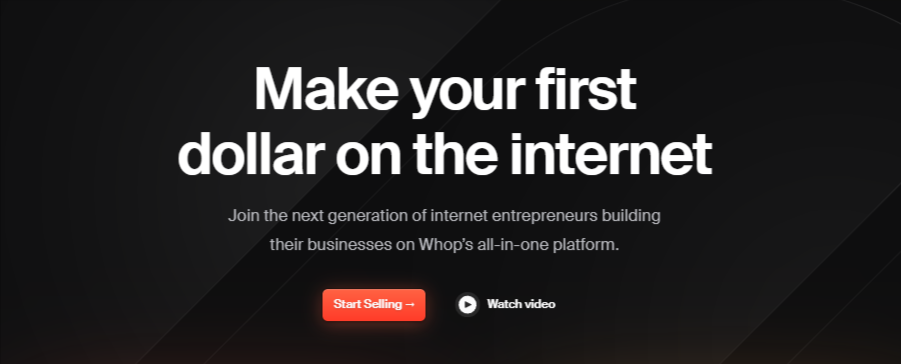
If you want to become a successful content creator making money online, Whop has everything you need to build and scale your business. Attract your audience, grow your brand, and monetize your content and digital products all in one place.
Sell directly to your audience by funneling them to your whop and list on Whop’s growing marketplace, where people can discover your great content.

Videos, courses, communities, newsletters, ebooks, podcasts…and more. The choice is yours.
And that’s just the start.
Our all-in-one platform takes away the stress by handling day-to-day hassles, like processing payments, marketing, and customer management.
Sign up for free and join over 25k content creators and entrepreneurs making their dreams a reality with Whop.





